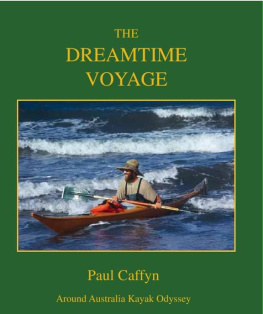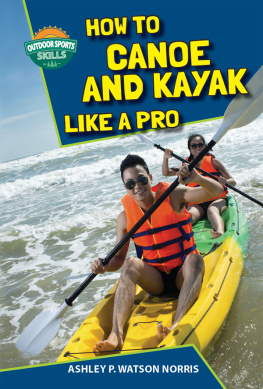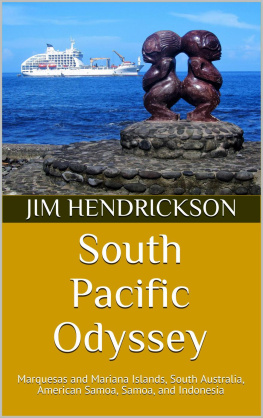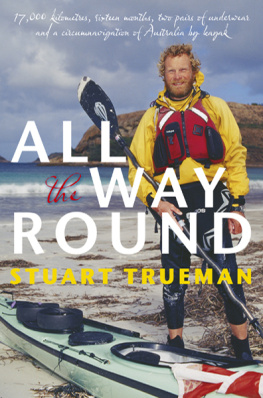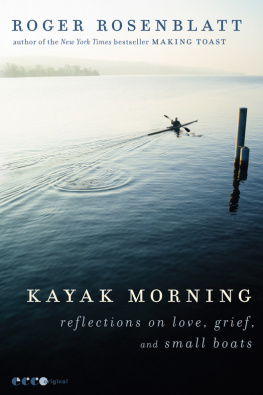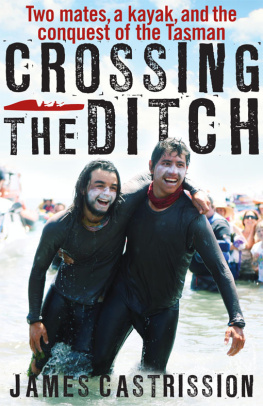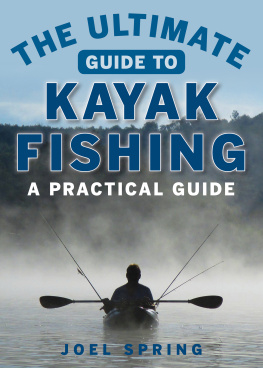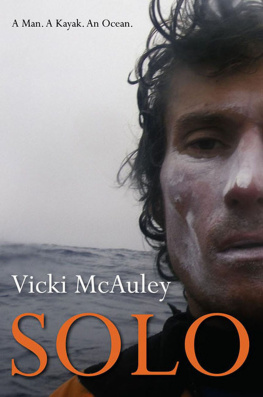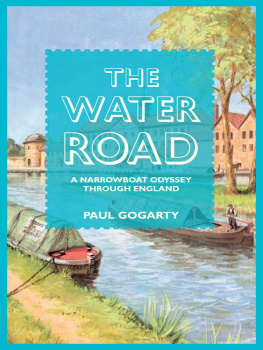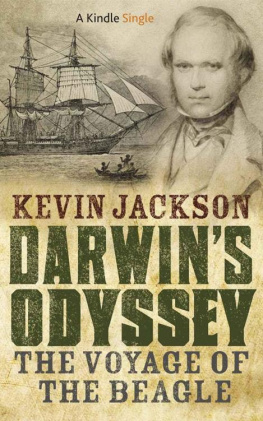Paul Caffyn - The Dreamtime Voyage: Around Australia Kayak Odyssey
Here you can read online Paul Caffyn - The Dreamtime Voyage: Around Australia Kayak Odyssey full text of the book (entire story) in english for free. Download pdf and epub, get meaning, cover and reviews about this ebook. year: 1994, publisher: Caxton Press, genre: Home and family. Description of the work, (preface) as well as reviews are available. Best literature library LitArk.com created for fans of good reading and offers a wide selection of genres:
Romance novel
Science fiction
Adventure
Detective
Science
History
Home and family
Prose
Art
Politics
Computer
Non-fiction
Religion
Business
Children
Humor
Choose a favorite category and find really read worthwhile books. Enjoy immersion in the world of imagination, feel the emotions of the characters or learn something new for yourself, make an fascinating discovery.
- Book:The Dreamtime Voyage: Around Australia Kayak Odyssey
- Author:
- Publisher:Caxton Press
- Genre:
- Year:1994
- Rating:5 / 5
- Favourites:Add to favourites
- Your mark:
- 100
- 1
- 2
- 3
- 4
- 5
The Dreamtime Voyage: Around Australia Kayak Odyssey: summary, description and annotation
We offer to read an annotation, description, summary or preface (depends on what the author of the book "The Dreamtime Voyage: Around Australia Kayak Odyssey" wrote himself). If you haven't found the necessary information about the book — write in the comments, we will try to find it.
Paul Caffyn: author's other books
Who wrote The Dreamtime Voyage: Around Australia Kayak Odyssey? Find out the surname, the name of the author of the book and a list of all author's works by series.
The Dreamtime Voyage: Around Australia Kayak Odyssey — read online for free the complete book (whole text) full work
Below is the text of the book, divided by pages. System saving the place of the last page read, allows you to conveniently read the book "The Dreamtime Voyage: Around Australia Kayak Odyssey" online for free, without having to search again every time where you left off. Put a bookmark, and you can go to the page where you finished reading at any time.
Font size:
Interval:
Bookmark:
THE IMPOSSIBLE DREAM
To the Australian Aborigines, the word Dreamtime encompasses everything that has transpired before living memory, how the vast country formed, how each lake, mountain and watercourse developed, and how the creators moulded clay to form the people. The traditional way of life, and social and cultural heritage, were all established in the Dreamtime. The word also attempts to convey the concept of a timeless past, and a future which will continue on for ever with the eternal spirit of the Aborigines. Individuals each have their own dreaming, the rites, myths and laws of nature passed on by word of mouth from their ancestors.
To myself, the word dreamtime always conjured up a fuzzy mythical quality of a place or a time I could never touch or see. It was an intangible term. I could only imagine what the dream time was like. As a child, confined frequently to the sick bed by bouts of bronchitis, my own dreaming was to be a great adventurer. My mother kept boredom at bay by maintaining a drip feed of exciting adventure books. I became an avid reader, especially after one long six month period confined to bed, while recuperating from acute nephritis. Joining Thor Heyerdahl on the Kon-Tiki Expedition across the Pacific Ocean, the Cockleshell Heroes during their wartime kayak raid up the Gironde Estuary, and climbing the final ridge of Everest with Hillary and Tensing instilled into me at an early age the desire to emulate their feats of discovery, courage and endurance. All through the years of schooling, that early dreaming of mine to be an adventurer simmered in the background, fostered further by library books on climbing expeditions and round the world yachting trips.
The desire to go where no one had been before was partly satisfied during my university days by the thrill of making first ascents of rock climbs and exploring virgin caves. Adrenalin rushes while balancing on thin moves, and the thrill of abseiling down 500 foot potholes led to short term satisfaction, but there was still a deep yearning to find my own destiny, to fulfil that childhood dreaming of questing for a big adventure. At the ripe old age of 31, and almost by accident, I began the first steps of a voyage into my dreamtime.
In 1977, during a chilly midwinter whitewater trip on New Zealands West Coast, the seed of my sea kayaking career was first sown. Although I had spent 10 years paddling Canadian canoes as a child and teenager, this sport slowly eased into a 20 year long period of dormancy, as the more challenging thrills of rockclimbing, caving and mountaineering swept me along. At the completion of the whitewater trip, Max Reynolds, Shaun Leyland and I stood shivering on a river bank, jogging on the spot to get the circulation going again while warming up internally with sips from a port bottle. A Kiwi, Colin Quincey had recently completed the first man-powered crossing of the Tasman Sea from New Zealand to Australia. His epic rowing trip in a dory was completed in 63 days. Deciding it was a stunning feat of endurance, we went on to joke about the idea of kayaking across the Tasman. The idea seemed a little far-fetched, even with a warming glow spread by the port, but we seriously considered the idea of paddling sea kayaks around New Zealand.
Max and I picked the toughest stretch of water around New Zealand to begin the New Zealand odyssey, the gale swept waters of Fiordland. By the skin of our teeth we survived the 350 mile journey, learning in the process many valuable lessons for surviving on the high seas. At Jacksons Bay, where we ended this first leg, Max and I reckoned our next trip by kayak would be across the Sahara Desert, as far away from the sea as we could imagine. There was no way we ever wanted to sit in a kayak again. Only a few weeks later, somehow those desperate memories of capsizing at night in surf and breakers toppling over us, had lost much of their drama. I felt a strong yearning to continue the kayak odyssey around the South Island. Max felt compelled to stay with a new job, so I found a friend willing to shadow me up the coast in my car, and carried on paddling right around the South Island.
The following summer, another dream was realized when I paddled my sea kayak Isadora around the North Island, accompanied by a team of friends on shore. Sea kayaking had really bitten me, for there was no way I could shake off the compulsion to plan and undertake another trip. Max teamed up with me again for a crossing of Foveaux Strait in August 1979, and a gripping but enjoyable trip around Stewart Island. The New Zealand odyssey was complete.
Only four months later, I was stunned by the news of Maxs death. Tragically, he drowned with another cobber in the flood-swollen waters of a river at the top end of the South Island. Together Max and I had forged a formidable partnership on the high seas. He had an irrepressible sense of humour and a kindred desire to tackle the unknown. I felt deeply saddened by his untimely death. I found that reading the funeral service was far more emotionally disturbing than anything we had ever faced at sea.
Two years of teaching music and outdoor education to teenagers at a local high school in the mid seventies had left my morale and self esteem at a low ebb. I had little spark, little zest to go out and make the most of New Zealands great outdoors. The odyssey around the three islands of New Zealand, where I was forced to rely implicitly on my own assessment of conditions and situations, had revitalized my confidence and self esteem. At the end of each big trip, I could look back with pride at the achievement of taking on a major challenge and ultimately attaining the goal. Aside from the challenge of the kayaking, another facet was the discovery of an extremely enjoyable way of life. Camping on beaches, poking into rarely visited ports, learning about the early history of each area, and being invited to join in the remarkable lifestyles of the coastal dwellers, evolved into a magic way of life. The encouragement of a shore-based support crew also added to the pleasure of the trips.
Like the drug addict cut off from his supply, a recurring problem with my sea kayak expeditions was the inevitable withdrawal symptoms or post trip blues. As the memory slowly faded, the trips began to take on a dream like quality. Sharp, vivid mental pictures of sharks, never ending cliffs, cyclones and gruelling hours on heaving seas take on a fuzzy mythical quality. Photographs and excerpts from diaries rekindle the memories, but the immediacy of the moment is gone forever. The only way to recapture the adrenalin rush of break-outs through massive surf, the magic of paddling through moonlit nights, and the thank God relief of escaping from a raging sea into the quiet tranquillity of a sheltered bay, is to dream up another outrageous, impossible dream.
Fortunately, when I began knocking out the big trips, the era of sea kayaking was akin to the golden 50s period of mountaineering when the major Himalayan peaks were being explored and scaled for the first time. Although a centuries old and traditional form of transport in the Arctic Ocean, sea kayaking in the new stable of fibreglass kayaks was in its infancy. My exploratory zeal could be fulfilled by tackling challenges that no one had attempted previously. There were more islands to paddle around for the first time, even continents.
After Max and I completed the Stewart Island trip, I began searching for another kayaking challenge. Two Victorian paddlers had completed the first kayak trip around Tasmania in 1979, so I began broadening my search to the Northern Hemisphere. Ireland had already been circumnavigated by a team of kayakers, but to my knowledge no one had been right around England, Wales and Scotland. In May 19801 teamed up with Englishman, Nigel Dennis, to complete a successful 2,200 mile kayak circumnavigation of mainland Britain. Post-trip blues set in quickly as Lesley Hadley, whod taken on the role of shore-based support crew, and I soaked up some culture in London. I knew the only remedy to leave the blues behind was to begin planning yet another trip. Australia had always been out of serious contention, because of its sheer length of coastline and three sections of cliffs, all over 120 miles long. In terms of distance the trip around Britain was the longest to date. Nigel and I had averaged 26 miles per day, including weather-bound days. During the last seven days to Holyhead, we averaged 44 miles per day including one sizzling 59 miler. At 26 miles per day, a paddle around Australia could almost be accomplished in 12 months, however I could not envisage any way of overcoming the long stretches of cliffs.
Next pageFont size:
Interval:
Bookmark:
Similar books «The Dreamtime Voyage: Around Australia Kayak Odyssey»
Look at similar books to The Dreamtime Voyage: Around Australia Kayak Odyssey. We have selected literature similar in name and meaning in the hope of providing readers with more options to find new, interesting, not yet read works.
Discussion, reviews of the book The Dreamtime Voyage: Around Australia Kayak Odyssey and just readers' own opinions. Leave your comments, write what you think about the work, its meaning or the main characters. Specify what exactly you liked and what you didn't like, and why you think so.

